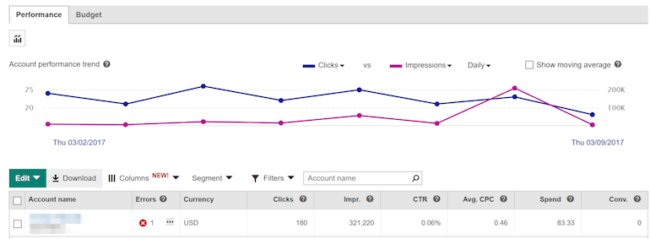What’s the end goal of any small business PPC campaign? Results. Results that show you that all the effort you’ve put into building, optimizing, curating, and monitoring your Pay per Click (PPC) ads matters and is paying off. Using valuable data in the form of performance metrics and reporting within Bing Ads and Google Ads helps you realize your ideal results, but the sheer volume of PPC data available can be overwhelming.
And what if you’re not sure what to look for in the first place? Customized reporting is great, but only if you understand how to select and use all the information to your benefit. Let’s dive into the data that PPC platforms like Bing and Google provide small businesses and identify 5 easy ways you can use the wealth of information available to make little PPC campaign tweaks that add up to big results.
Impressions
PPC impressions are the number of times an ad has been displayed on search results pages. In this case, the metric isn’t about tracking clicks, but it’s about visual awareness. Without impressions, nobody sees your ad, if they don’t see your ad, there’s no chance of clicks or conversions. Impression share is the number of times your ad is shown as a percentage of the total available impressions in the market you’re targeting. So, if one of your keywords has a 15 percent impression share, that means that your competitors own the other 85 percent. Boosting your impressions and/or impression share can be done by increasing your bids and/or budgets.
Click Through Rate (CTR)
This data point represents the number of times an ad was clicked, divided by the number of times the ad was shown (impressions). For example, if your ads had 60 clicks out of 2,500 impressions, your CTR is 2.4 percent.
This metric can help small businesses judge the effectiveness of their ad copy. If you notice a high number of impressions, but a low CTR, that means people are seeing the ad, but the content isn’t compelling or convincing enough to be clicked on. There’s a messaging disconnect that needs to be fixed. A good CTR is around 2 percent; if your CTR is below 1 percent, reevaluate your ad copy and how the content can be used to better connect to your targeted audience.
Cost Per Click (CPC)
An account’s CPC is the total cost of all clicks on an ad divided by the number of clicks. It shows you the average amount your account is charged each time your ad is clicked. So, if you paid $66.50 for 250 clicks, your average CPC would be $0.26. This little number is very important as it helps you as a marketer evaluate your return on investment (ROI). Your established budget is closely related to what you’ve determined is an acceptable ROI, and by tracking your CPC over time, you can understand if the investment is paying off. And if it isn’t, take steps to fine tune and tweak your PPC campaign, using this metric to track your success.
Conversion Rate
This is where you can really see all your PPC strategy paying off. A conversion is the completion of an action by a customer after clicking your ad. This action could be purchasing your product, signing up for a newsletter, requesting a quote, etc. The higher the better, but a good conversion rate is usually between 2 and 3 percent. As you know, a well-placed, well-written ad is only half the battle. Once consumers are taken to the landing page, the ad’s job is done. If your CTR is strong, but there are few conversions, you’re investing in ads that aren’t bringing in profits. Boost your conversion rate by improving your landing page, making sure it’s well-organized, easy-to-use and matches what’s being advertised in the PPC ad.
Cost Per Conversion (or Acquisition)
This is one of the most important metrics to watch in PPC, providing you with the aggregate cost to acquire one paying customer on a campaign. Hitting your cost per conversion goal tangibly displays the success of your PPC campaign. The lower the cost per conversion (when analyzed against your budget) the better your campaign is running. A low CPA means you’re driving a strong return on investment while leveraging affordable, relevant keywords. If your CPA is too high, try lowering your bids, finding more specific keywords to target and improving your ad copy.
Report on your success
Once you’ve created your campaigns, written your ads, and refined your keywords, it’s time to take advantage of your account’s search advertising capabilities and rich data reporting. Use the top 5 data points above to quickly measure your campaign’s performance, making sure your investment is working for you, not against. Tracking the metrics that are important to you allows you to more accurately test your campaigns and learn how to optimize your campaigns for performance. Testing, learning, and refining your campaigns will help ensure the metrics you want to see improve actually do.




